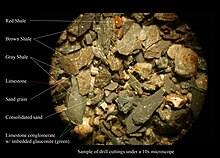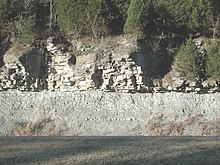Shale

Shale (also called mudstone) is a fine-grained sedimentary rock whose original constituents were clay minerals or muds. It is characterized by thin laminae[1] breaking with an irregular curving fracture, often splintery and usually parallel to the often-indistinguishable bedding plane. This property is called fissility. Non-fissile rocks of similar composition but made of particles smaller than 1/16 mm are described as mudstones. Rocks with similar particle sizes but with less clay and therefore grittier are siltstones. Shale is the most common sedimentary rock.[2]

Formation

The process in the rock cycle which forms shale is compaction. The fine particles that compose shale can remain in water long after the larger and denser particles of sand have deposited. Shales are typically deposited in very slow moving water and are often found in lake and lagoonal deposits, in river deltas, on floodplains and offshore of beach sands. They can also be deposited on the continental shelf, in relatively deep, quiet water.
'Black shales' are dark, as a result of being especially rich in unoxidized carbon. Common in some Paleozoic and Mesozoic strata, black shales were deposited in anoxic, reducing environments, such as in stagnant water columns.
Fossils, animal tracks/burrows and even raindrop impact craters are sometimes preserved on shale bedding surfaces. Shales may also contain concretions.
Shales that are subject to heat and pressure alter into a hard, fissile, metamorphic rock known as slate, which is often used in building construction.

See also
Footnotes
- ^ "shale". Chambers Dictionary of Science and Technology. Chambers Harrap Publishers Ltd. 1999.
- ^ "Rocks: Materials of the Lithosphere - Summary". Retrieved 2007-07-31.
References
- Blatt, Harvey and Robert J. Tracy, 1996, Petrology: Igneous, Sedimentary and Metamorphic, 2nd ed., Freeman, ISBN 0-7167-2438-3
